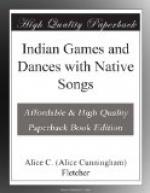Every correct guess counts one for the side of the Guesser. As soon as a correct guess is made, the Judge for that side takes up one of the tally-rods and lays it toward his side; this shows that a point has been won for that side. If the guess is wrong, the Judge for the other side takes up one of the tally-rods and lays it over on his side. The other side has lost one, while his side has gained by the other’s loss.
To win a sweep, all the eight tally-rods must be gained by one side. Three sweeps by a side gives that side the game.
Whenever a sweep is made the balls are handed over to the Custodian. The two Judges rise, go to the standard, stand there, one facing North (his side), the other the South (his side). The two Guessers go to the standard, stand there, one facing East, the other West. All the winning side rise, go toward the standard and form a circle around it. There they sing the Victory Song.
VICTORY SONG
[Music]
As they sing they sway their arms as though hiding the balls, and dance to the rhythm of the song. Four times they dance around the standard and sing the Victory Song. All movements must be in time with the song. At the close of the fourth circuit of the standard, all return to their appointed places and the game is resumed.
The Custodian takes up the drum, carries it to the side that has just danced and sets it before the three Singers of that side. The Guesser, who is of the opposite side, designates the two who are to hide the balls and the game proceeds as described above.
Whenever a side that has been hiding the balls fails three times to elude the Guesser, then the Custodian takes the drum from that side and carries it to the other side of the circle, puts it before the Singers and gives the balls as directed. Sometimes there are disputes as to these transfers and as to the points lost; three must be lost to secure a transfer. It then becomes the duty of the Judges to decide.
With every transfer of the drum the song changes. The balls and the right to sing go together, but the song belonging to one side must not be sung by the other side. The songs are not interchangeable.




